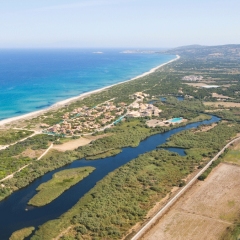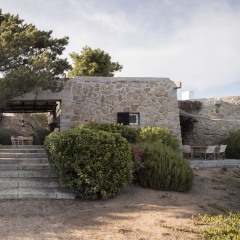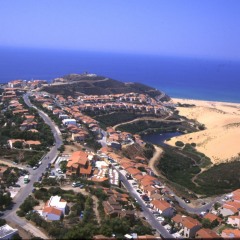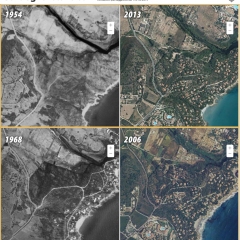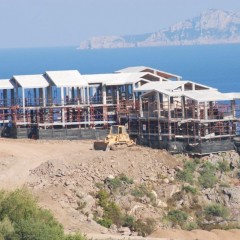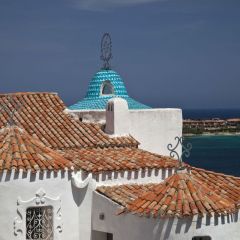Sardinia: a land of experimentation, uncertain balances and hopeful solutions.
The 2020s opened with a general context of climate and environmental crisis, but not only.
If you look exclusively at the italian context, the picture of climatic consequences and environmental damage is configured in extreme situations and damage from hydrogeological instability more and more frequent, and above all of large entity. If this geoclimatic situation is accompanied by the economic and political crisis of the Bel Paese – the absence of public investment, environmental miseducation, land abuse, real estate crisis, just to name a few – the ensemble worsens drastically, both in the immediate perception and in the simulations of future growth and development.
Architecture and urbanism are undoubtedly among the cornerstones of balance having a significant weight in the overall picture, playing a not peripheral role in the chain of economy, public health and welfare in general. Where architectural and urban culture are precarious or placed in the second, third or fourth floor, then there are necessarily consequences in all other fields, be they short or long term.
How, then, to intervene as architects, urban planners or technicians? The Autonomous Region of Sardinia could be the example to follow, on whose model it is possible to improve.
An emergency beyond the big cities
There is no doubt that today there is a need for a new vision, with the requalification of existing urban realities and the planning of their expansion, but above all the care and protection of what surrounds them; a programmatic approach more focused on the landscape, the climate and, not least, a lower consumption of land.
Alongside the much-debated themes of urban parks, vertical woods, forestation of cities and many other projects that try to improve in the short and long term the living conditions and environmental impact of the cities, there is an Italy made of small and medium urban centres, endless countryside and coasts. It is an Italy that struggles, especially in the South, with the hydrogeological instability, the lack of infrastructure and rhythms of life completely different from those today considered “hot”. It is the rest of the Italian territory that is left to itself and characterized by a local planning at the municipal and regional level without major landscape objectives, often lacking even the minimum housing qualities and choices oriented towards a “better” future capable of learning from its mistakes and acting before it is too late.
The further away you are from the urban centre of medium and high importance, the more this attention to a more homogeneous and calibrated design tends, with some exceptions mainly widespread in Northern Italy, to decrease.
A tangible proof of this situation is the worrying situation of the Building Regulations, a primary and basic tool for building and designing in the municipalities. They are still missing in some smaller towns, and are followed by as many absents as the Detailed Plans, Municipal Urban Plans and the Municipal Coastal Plans. If present, however, they are often lacking in quality and realized only for the purpose of fulfilling legal obligations.
In this regime of discontinuity, the regional administrations are in charge of homogenizing the guidelines of the Municipal Plans, and the State, also through special national laws (see how the “Decreto Sblocca Italia” (Unblock Italy Decree)¹ wanted in 2014 by the Minister for Simplification tried to stem this dilemma with a Regions-State-Municipalities agreement for the “guided” compilation through a standard Building Regulation document), tries to force the hand.
But far from the great Excellencies that often appear in newspapers, far from the limelight of “green marketing” signed by big names, there is an Italy that does not appeal to professionals and tries, through office technicians, to fulfill the obligations without thinking about the design quality and the environmental, economic and social consequences.
Sardinia between highs and lows
If there is a reality that is not exempt from these problems it is the island of the Autonomous Region of Sardinia.
Sardinia is a land of contradictions, marked by poverty and a perennial internal crisis, often disconnected from national crises, but linked to the characteristics of its political and social situation. Despite this, it has always managed – with different motivations and through diversified tools – to take care of its landscape aiming at a balance between development, economy and environment.
The island today presents itself as a land made up of very few cities and which actually represents a summary of the great differences that characterize Italy. Its territory is largely open countryside and its population density of 68 inhabitants / sq km is among the lowest in Italy², the lowest if we consider the regions with more than one million inhabitants.
Today, the island presents itself as a land made up of very few cities and which actually represents a summary of the great differences that characterize Italy. Its territory is largely open countrysideand and its population density of 68 inhabitants per km2 is among the lowest in Italy², the lowest if we consider the regions with more than one million inhabitants. It represents one of the economically advanced European regions that coexists with a fundamentally intact ecosystem, with large portions of almost virgin territory. And that is why its landscape approach can be an example for all those regions that still try to preserve their naturalness and that want to anticipate – in the desired hypothesis of growth in the coming decades – the large consumption of land, the loss of naturalness of the coasts and the inevitable climatic and environmental consequences, which would add to those already perceptible in these years of great global upheavals.
From Forests to Coasts
First of all, it is important to understand that the problem of land consumption and environmental damage is much more recent than we think, even if it is not difficult to encounter extreme situations prior to the 1980s, when the tourist boom in Sardinia began to affect all the coasts of the island and not only locally concentrated points³. This is because the abandonment of the lands during the second post-war period allowed natural vegetation to expand in those places where, up to the 19th century, there were massive primary forests that covered about two-thirds of the island and which were almost completely deforested for the use of timber (coal production, construction of railway sleepers for the Peninsula and beyond)⁴.
Despite these deforestations, Sardinia has remained one of the wildest and greenest lands in the Mediterranean. It maintained the wild character that stimulated the strong relationship with nature in the population. The demographic fluctuations have subsequently caused the expansion of the woods in previously cultivated areas, but the trend has been that of a contraction of the forest areas.
To protect this secular heritage at risk, the Autonomous Region of Sardinia has always supported the creation of regulations and bodies that worked for the protection, prevention, maintenance and safeguarding of forests in general. Today, similarly to other regional agencies that deal with the educational, cultural, social and anthropological sectors, there is a sector of public officials of the Region that is exclusively dedicated to this work, through the former Sardinia Forestry Authority (now merged into the Agency Forestas)⁵.
A new chapter began with the birth of seaside tourism which in the same post-war period bagan to consolidate on the Sardinian coasts.
In some realities such as the Costa Smeralda, the private desire to recreate a natural and well-kept environment – also thanks to the huge amount of money and investments – has meant that a balance between nature and built environment was found as early as the 60s of the last century. The “Costa Smeralda Model”⁶ contends for the title of “most desirable”⁷ for the development of the Sardinian coasts for the ability to alternate built and green, natural space and urbanization, net of social controversy on the type of visitors and users⁸. However, it also contends for the title of “most disrespectful and unsustainable”⁹, because it focuses on a coastal development of seriality and complete insensitivity to local vocations.
The predominance of villas and the abundance of gardens, respectful of the Mediterranean bush and designed to fit with as little damage as possible within the rocky hills of Gallura, is today the best example not of “mass tourism for billionaires”, but of landscape ability to think of a balanced but effective model that remains current over time allowing a measured development of the built.
At the same time, in the same years, but in other parts of the island, the complete freedom of construction and the absence of well-defined local landscape regulations (such as the non-need for building permits issued by the municipality) allowed the construction of similar works with the environmental care and architectural design much less refined, and often in the total absence of municipal authorizations.
However, the building growth rate was so low that in most cases the damage was quite small. Moreover, the need for occupation of the island population had allowed, through the newborn Forest Authority¹º, to compensate for the construction with large and impressive planting campaigns¹¹.
Although not connected to the building aspect, a first stop to the few projects that were built on the coasts was given when the Region, between 1950 and 1962¹², has radically changed the coastal landscape with a landscape intervention¹³ aimed at stemming the overflowing of the coasts and the reclamation of marshy lands, mainly through hydraulic-forestry works and hundreds of thousands of hectares of Maritime Pine plantations. No pine forest on the island is endemic, despite the fact that today they are part of the landscape and the total intervention financed by the Southern Bank (Cassa del Mezzogiorno) concerned over 1 million hectares¹⁴. It was the first step against the desertification of the island¹⁵, albeit for agricultural and landscape reasons.
The Basics of Regional Urbanism
Starting from this situation, more awareness of the island’s environmental and landscape value has gradually been acquired, which has also caused, negatively, a certain slowness in the formulation and application of effective and advanced local urban plans.
In order to fight the unregulated tourist-building boom following the success of the Costa Smeralda (capable of outclassing the feeling of connection with the local culture), the Region was forced to stem the construction of accommodation facilities and housing in the coastal areas, as the municipalities did not act promptly. While the Region was already preparing its own Regional Landscape Plan, the Ministerial Building Decree of 1967¹⁶ began to impose more reasoned constraints. Despite this, the abuse of lands was widespread and relentless and led to the creation, in 1985 and after various experiments, of a specific forest police, the Forestry and Environmental Surveillance Corps (Corpo Forestale e di Vigilanza Ambientale), which explicitly dealt with the protection of the landscape and the war against illegal building. In this period, the intensity of real estate interests and illegal tourist construction became so acute that the natural characters and settlement traditions were completely distorted, to the point of presenting irreparable scenarios.
The small population and the stalemate that had always characterized Sardinia are no longer, suddenly, the fundamental elements of an environmental and landscape balance. The Region thus begins to outline a process for the best management and protection of the environmental heritage. It starts with contributions to municipalities for compliance with the 1967 Law and the drafting of urban plans and building regulations¹⁷, continues with the classification of construction areas¹⁸ – from A to G, in ascending order of protection -, passing through the pre-existing structures and those of future construction (1981). The most complete and definitive Regional Law on the organization and coherence of the building and urban planning tools of the administrations will follow (Regional Law of 1985, “Rules for the use and protection of the regional territory”¹⁹).
To make a comparison, in terms of timing and evolution of regulations, the Autonomous Region of Sicily promulgated the Urban Planning Law of Competence in 1978 and, after additions that do not substantially change, proposed a complete revision only in 2019²º.
With the 1993 adjustments, the characteristics that governed urban expansion and environmental protection were definitively outlined until 2006, when they were integrated into the new Regional Landscape Plan.
It is forbidden to build, in any situation, less than 300 meters from the shoreline, even in high areas not at the sea level. It is the absolute prohibition zone, which still binds the placement, installation and connection of kiosks, walkways, services and any artifact, even removable. It is established, in fact, that the frontline coastal strip is an absolute unavailable asset.
This constraint is accompanied by the possibility of ordinary and extraordinary maintenance, static consolidation and conservative restoration as long as they do not alter the state of the places, do not increase the surface of occupied land and do not increase the volumes. Some exceptions, but never towards the sea, are allowed to hotel and tourist activities in order to rationalize their facilities.
The same rules force municipalities to adopt Urban Plans and Landscape Plans, in agreement with Provinces and Mountain Communities (now abolished), which plan the expansion and future subdivisions of urban centers, also outlining the areas intended for absolute protection.
A novelty is also introduced: in addition to the traditionally established cubic volume indices, the minimum building ratios are set outside the urban fabric and outside the band of absolute prohibition, establishing the principle that, to build in the countryside, there must be a minimum intervention area equal to 3 hectares for housing and 5 hectares for other activities.
The Regional Landscape Plan is not perfect, but it works. Especially because it manages to homogenize construction throughout the Region, it blocks important building speculations during a thriving tourist period in expansion and lays the foundations for a landscape protection not only “natural”, but also architectural.
Architectural aspects
The Region, in accordance with the Fine Arts, is also responsible for regulating and evaluating the architectural characteristics that buildings – be they houses, hotels, industrial structures or other – must have to receive approval, both in the urban and suburban context. It is no longer just the municipality that, according to its own Building Regulations, approves the architectural design of a new building, but also the Region expressly requests respect – even within urban centers – for the formal and stylistic characteristics that represent Sardinian architecture outside large and medium-sized cities. In this regard, the bureaucracy establishes approval both by the Office of Fine Arts and Heritage Protection and by the Regional Office for the Protection of the Territory.
While it was possible to build condominiums and large terraced complexes in the provincial capitals and major urban centres of the island before the new rules, since 1993 the Region has been in favour of the Mediterranean type of single and two-family houses with gardens or courtyard in all those centres where buildings with more than three floors have not yet developed.
However, an explicit line of stylistic and architectural features for the buildings is not defined: they are generated almost spontaneously, especially in ambiguous contexts such as the suburbs of new subdivision of small towns, clashes that limit and discourage the arrival of contemporary style in Sardinian homes. Those projects that recall the more archaic and rural forms of “country houses”, traditional houses and even modest noble palaces are favored.
During this period, the Region strives to overcome the problems and disparities that could arise between one municipality and another, establishing generic but significant guidelines. The “Sardinian Mediterranean” style (already experimented in the fifties and sixties by pioneer architects such as Marco Zanuso and his “Arzale House”, in the photo) becomes, with its local variations, the sample language to be inspired by, in particular the one experimented in the Costa Smeralda, although it was totally invented by the architects Luigi Vietti, Jacques Couelle and Michele Busiri Vici during the design of the village of Porto Cervo, with the support of the Municipality of Arzachena, then taken up in other realities such as the Hotel Su Gologone by Giovanni Antonio Sulas.
This tool seeks to avoid the major building abuses that have characterized the previous decades and which proved to be poorly qualitative from an architectural and landscape point of view, unable – despite having the value of proximity to the sea – to convey that sense of balance and harmony that other more careful interventions had managed to achieve in areas such as the Costa Smeralda and the territories adjacent to it.
Sardinia leading the way and construction crisis
If today the architectural severity has, in some ways, decreased and more variations of style and customization have opened up, as long as they are judged to be coherent and in any case respectful of the surrounding landscape, it is no longer harmonious the landscape story that animates, even in these weeks, the Sardinian scene, both political and intellectual.
Thirteen years after the changes to the local regulations, in 2006 the PPR²¹ was finally approved, which tightened the construction criteria and aimed at greater rationalization of urban centers, leveraging the role of municipal administrations, which over the years had remained in the shadows.
With the Regional Law n. 8 of 2004, Sardinia is the first region to adopt a Regional Landscape Plan (PPR)²². It does so by concentrating all its energies on the coastal areas, and putting aside, in anticipation of a future development, the internal territories. The fundamental principle of the whole norm is that the landscape is the main resource on which to invest in the future, thanks to its intertwining of place, people, history and nature²³.
«With this law – argues Cesarina Siddi, Professor of Architectural and Urban Composition at the University of Cagliari – the Region has launched one of the most innovative political actions for the preservation and enhancement of the environmental heritage of the coasts, subjected for decades to the pressure of tourist and real estate interests.»²⁴
With the approval of the PPR, strongly desired by the then President of the Region Renato Soru and carried out under the guidance of the urban planner Edoardo Salzano²⁵, a new significant constructive constraint was added to the newborn band of 2 kilometers from the shoreline (limit initially provided by the Temporary Administrative Provision called “Law Saving Coasts”). The Soru Landscape Plan ranged from coastal maintenance to sustainable development of the territory, specifically defining exceptions, areas of validity, limits and criteria. However, the smaller islands around Sardinia and the urban centers that were within this new “coastal belt” were regulated by special exceptions.
The rest of the planning is entrusted, according to the guidelines specified by twenty-seven Landscape Areas, to the Municipal Urban Plans, so that each territory can better plan its future and its expansion based on common principles (such as the prohibition, always in the coastal belt, of building new accommodation facilities, new industrial buildings or large shopping centers, golf courses, equipment for campers, etc.).
In addition, to further constrain any local pressures on the new Urban Plans, the newborn regulatory instrument identifies areas of respect, including SIC areas (of community interest such as parks, mountains and reserves), protected natural areas and areas with hydro-geological constraints. It establishes the importance of reserves, natural parks, planting areas, state-owned forests and other areas of interest.
It is a completely new approach to the construction management in Sardinia, so much so that, in the years following its approval, the PPR has been the object of international attention, as well as of other Italian regions.
The aim of the law was also to shift the balance of tourism further inland, taking example from the situation in Corsica, where even the hills are a destination for seaside tourists who cannot or do not want to stay directly on the coast. Similarly, the law helps to mend the urban fabric of those countries which have numerous unedited urban lots and which determine a lesser rationalization of services and buildings.
The PPR was not exempt from either criticism or repercussions on the economic level, and was judged to be incomplete and too rigid. Even the Sardinian media heavily attacked the new protection system, but this did not prevent its approval which, in fact, in the following years – also due to the global economic crisis of 2008 – led to a serious construction crisis in Sardinia, which lasted until 2010.
The Plan, on the other hand, did not provide for funding or alternatives for the building development of Sardinia, nor did it propose ways to expand the existing rural architecture, completely eliminating the possibility of enhancing the abandoned or decaying rural architectural heritage. Even the projects already approved, but not yet built, found great difficulties in implementation and saw the light only thanks to long discussions and compromises with the regional offices.
Attempts to improve and future prospects
The situation has evolved over the years and several technical changes followed one another with subsequent administrations. The coastal strip now ranges from 300 meters to 5 km, adapting to the morphology and the various realities of the coasts and territories. Non-coastal agricultural areas have undergone new landscape protection criteria and the House Plan has been repeatedly implemented trying to include clauses and articles that would allow a timid but perceptible resumption of construction (such as the adjustment to 3 hectares of minimum surface intervention for each intended use)²⁶.
In 2009, the theme of climate and energy issues was added and, in line with the Landscape Plan, the Region published specific guidelines and regulations on the subject, identifying suitable or unsuitable areas, and the installation conditions for renewable energy production plants²⁷.
The architectural aspect of the Landscape Plan is still linked to the tradition and stylistic coherence of historic centers, rural houses and the “Mediterranean” style. The implementation of environmental protection regulations took place in parallel with the regional building vicissitudes, and all the municipalities have – in a more or less in-depth way – adapted to the obligation to draw up Urban Plans, Detailed Plans and Coastal Plans and Use of Coasts.
Sardinia, for now, has averted the increase in land consumption and vented its difficulties on other aspects which – while complicating the economic and social situation of the population – promote the environmental and landscape balance of the island.
Today the Region protects, with various instruments, 18% of the territory in an inviolable way²⁸ and protects with different levels of constraint the remaining 72%²⁹, ensuring the basis for a future that can respect nature, also opening up to economic and social development. It has developed, to the utmost of its possibilities and finances, a system of environmental, technical and cultural programming, protection and dissemination, which ranges from curiosities to the history of institutions, from standards to maps, up to touching the multimedia format with a Geoportal³º that represents the geo-localized territory through historical views that reach up to the 40s. It provides students and professionals with tools and knowledge that allow them to extend their sensitivity, careful and respectful planning in all its training and project phases. Sardinia, at least as regards the environment, is investing in its future.
Is it a happy and perfect island? Of course not. If other chapters were to be opened, even on the subject of landscape, urban planning and architecture, significant flaws could be found in the regional and municipal regulations. But the issue is that the Region of Sardinia has always had a clear and fixed objective of environmental protection, also in relation to tourism; just as there are many other issues to be improved, from infrastructure to public transport, from unemployment to planning for the future.
The interventions to resolve the hydrogeological instability are on the agenda and are the heaviest expenses of many municipalities on the island, which still struggle with the consequences of illegal activities or with the failure to build infrastructures financed by the State and/or by the Regional Administration.
There is a risk that tomorrow a new PPR will be approved and that there will be nothing left of the Sardinian coast. Speculation is always behind the doors and recent bills are still under discussion³¹, but the awareness and cultural attachment of Sardinians to their island is a value that holds back even the most determined lobbyists.
It almost seems that a land where separate collection covers 86% of waste³² and where there is the highest Italian average in terms of vehicle age (10 years and 9 months)³³, does not feel that much the weight of the climate crisis. Or rather, it seems that the latter is late in materializing into visible and perceptible elements with violence and constancy.
Surely the future of our cities and our territories will have to be in the name of “green” and the total reduction of energy consumption, protection of the soil and natural resources, yet it is also necessary to establish a different applicability of the solutions for each territory in which these are put into practice. By ensuring that not only the design and programming choices are required by law, but that they become a cultural-based modus operandi, exportable to all those territories where it is difficult to imagine a “Vertical Forest”, but it is easier to think of a more spaced and green urban fabric, more open to the integration of nature and the environment.
The “Costa Smeralda model” will certainly not be the Eden of the landscape, but from such a careful development model it is possible to learn from mistakes, improving and integrating the knowledge acquired over time, making an indispensable development accord with the landscape protection of the lands still to evolve, establishing new design parameters.
The goal seems to be that of a homogenization of buildings and greenery: where there is one, the other cannot be missing. A “sustainable” planning that allows towns and villages to necessarily develop with gardens, wide tree-lined streets, green roofs and embankments, and other interesting choices that can respond to the request for landscape protection without giving up construction in less anthropized environments. But to talk about this aspect it would take a much broader and more complex discussion.
Today we are still in time to plan those areas where urban forestation is not needed, but we need the ability to establish new architectural criteria, territory, environment and landscape ante aedificationem. Before it’s too late.
Apostille:
This article was written in early December 2019, when the update to the PPR by the Sardinia Region, with important changes in terms of building facilitation, was still under discussion at the Regional Council. After the approval at the end of the year, the “Sardinia House Plan” undermined the objectives and purposes of Soru’s PPR. Subsequently, in July 2020, the General Superintendence of Cultural Heritage and Landscape of Sardinia, and a joint action of the Ministries of the Environment and of Cultural Heritage and Landscape, challenged the new Sardinian Law, raising doubts of constitutionality in the parts concerning the failure to safeguard the territory and the common good which is the Sardinian natural landscape. At the time of publication, therefore, the strict legislation of 2006 and the considerations made up to now remain valid.
Translated into English by Gabriele Agus.
¹ LAW-DECREE 12 September 2014, n. 133, “Misure urgenti per l’apertura dei cantieri, la realizzazione delle opere pubbliche, la digitalizzazione del Paese, la semplificazione burocratica, l’emergenza del dissesto idrogeologico e per la ripresa delle attività produttive.” (“Urgent measures for the opening of construction sites, the construction of public works, the digitization of the country, bureaucratic simplification, the emergence of hydrogeological failure and the resumption of production activities.”), converted with modifications from Law 11 November 2014, n. 164.
² Istat data, Resident population as of 31 December 2018, Istat, www.istat.it, date of consultation 31/12/2019.
³ G.M. Ugolini, La Costa Smeralda e l’Invenzione del turismo in Sardegna, on L’Italia e le sue Regioni, Milan, Treccani, 2015.
⁴ E. Beccu, Tra cronaca e Storia: Le Vicende del Patrimonio Boschivo della Sardegna, Sassari, Carlo Delfino Editore, 2000.
⁵ In this regard, all documents, standards, information and prescriptions are contained by topics on the official regional websites: SardegnaTerritorio.it, SardegnaAmbiente.it e SardegnaForeste.it.
⁶ G.M. Jonghi Lavarini, F. Magnani, In Costa Smeralda. Il Segno dell’Architetto, Milan, Di Baio Editore, 1991.
⁷ G. Baffigo, Turismo e ambiente sono compatibili. Il modello Costa Smeralda lo dimostra, on La Nuova Sardegna, of the 03 October 2011.
⁸ C. Beghelli, Di lusso e sostenibile: i due volti del turismo che faranno crescere la Sardegna, on Il Sole 24Ore, of the 27 February 2019.
⁹ C. Siddi, Sardegna e Sostenibilità. Tra il dire e il fare…, Eco Web Town – Journal of Sustainable Design, www.ecowebtown.it, issue 5, December 2012, date of consultation 15/12/2019.
¹º Ente Foreste della Sardegna, now FORESTAS, Regional Forestry Agency for the Development of Territories of Sardinia’ environment, www.SardegnaForeste.it, date of consultation 20/12/2019.
¹¹ The dating and planting of the Sardinian coasts can be seen in the historical aerial photos of 1954 and 1968 available on www.sardegnageoportale.it, date of consultation 12/12/2019.
¹² G. Barbero, U. Terenzio, P. Steccanelia, N. Fenicia, P. Vicinelli, R. Dentice di Accadia, C. Aiello, A. Panattoni, E. Calamita, R. Rossini, G. Cesarini, A. Frazzitta e P. E. Sodini, Cassa per il Mezzogiorno, Dodici anni 1950-1962. L’attività di bonifica (“Twelve years 1950-1962. The reclamation activity”), ASET (Archives of Territorial Economic Development), www.aset.acs.beniculturali.it, Bari, Laterza, 1962.
¹³ Royal Decree of 13 February 1933, Nuove Norme per la Bonifica Integrale (“New Rules for Integral Reclamation”).
¹⁴ See note 12
¹⁵ Recupero delle Pinete Litoranee: Interventi su Scala Regionale (“Recovery of Coastal Pine Forests: Interventions on a Regional Scale”), of the 05 November 2014 available on www.sardegnaforeste.it, Sardinia devotes two decades to the total implementation of the rules laid down in the 1933 Integral Reclamations Act.
¹⁶ Law 6 August 1967, n. 765 (Amendments and Additions to the Urbanistic Law 17 August 1942, n. 1150), Legge Ponte (“Bridge Law”), available on www.gazzettaufficiale.it.
¹⁷ Regional Law 28 August 1968, n. 40, Contributi ai Comuni per la redazione dei regolamenti edilizi e degli annessi programmi di fabbricazione (“Contributions to the municipalities for the drafting of building regulations and related manufacturing programmes.”), available on www.regione.sardegna.it.
¹⁸ Regional Law 9 March 1976, n. 10, Norme in materia urbanistica e misure provvisorie di tutela ambientale (“Urban planning rules and provisional environmental protection measures”), available on www.regione.sardegna.it, then replaced by the Regional Law 19 March 198, n. 17, Norme in materia urbanistica – Abrogazione delle leggi regionali 28 agosto 1968, n. 40, e 9 marzo 1976, n. 10; integrazioni alla legge regionale 28 aprile 1978, n. 30, available on www.regione.sardegna.it.
¹⁹ Regional Law 22 December 1989, n. 45, Norme per l’uso e la tutela del territorio regionale (“Rules for the use and protection of regional territory”), available on www.regione.sardegna.it.
²º Sicilia: Dopo 41 anni arriva la riforma urbanistica (“Sicily: After 41 years the urban reform arrives”), Sicily Region, www.regione.sicilia.it, date of consultation 12/13/2019.
²¹ Regional Law 25 November 2004, n. 8, approved on 5 September 2006, available on www.sardegnaterritorio.it.
²² Regional Law 25 November 2004, n. 8, Norme Tecniche di Attuazione (“Technical Implementation Rules”), available on www.regione.sardegna.it.
²³ E. Salzano, La Filosofia Del Piano. Appunti e materiali per l’intervento di Edoardo Salzano (“The Philosophy of the Plan. Notes and materials for the intervention of Edoardo Salzano”), Autonomous Region of Sardinia – Study meetings on the Regional Landscape Plan, 2006.
²⁴ C. Siddi, cited.
²⁵ E. Salzano, Lezione di Piano. L’esperienza pioniera del Piano paesaggistico della Sardegna raccontata per voci, Venice, Corte del Fontego Editore, 2013, available on www.docplayer.it.
²⁶ On the website www.sardegnaterritorio.it there is a complete documentation of all changes from 2007 to today. The latest, at the time of writing the article, is from 11 January 2019.
²⁷ Regional Law 7 August 2009, n.3 – DGR del 06/2011, Linee guida attuative del decreto del Ministero per lo Sviluppo Economico del 10.9.2010 “Linee guida per l’autorizzazione degli impianti alimentati da fonti rinnovabili” (“Implementation guidelines of the decree of the Ministry for Economic Development of 10.9.2010 “Guidelines for the authorization of plants powered by renewable sources””).
²⁸ Ministry of the Environment and the Protection of the Territory and the Sea, Rete Natura2000, SIC, ZSC e ZPS in Italia, www.minambiente.it, last modified April 2020, date of consultation 20/04/2020.
²⁹ Since there are no aggregate data that can be found in percentages beyond the SIC, ZSC and ZPS areas, to 18% you have to add all those sites that for various reasons do not fall into these categories (www.sardegnaambiente.it).
³º Geoportal of Sardinia, SardegnaGeoportale, www.sardegnageoportale.it, date of consultation 22/12/2019.
³¹ At the moment, a real PPR from scratch is not contemplated, but the bill for the Piano Casa (“House Plan”) 2020 contains heavy changes to the requirements of the current plan:
– L. Roj, Ecco il Nuovo Piano Casa, presentata la legge (“Here is the New House Plan, presented the Law”), La Nuova Sardegna, www.lanuovasardegna.it, last modified 16/10/2019, date of consultation 10/04/2020.
– M. Melis, Salviamo la Sardegna: 10 mila firme da tutto il mondo contro il cemento in riva al mare (“Let’s save Sardinia: 10 thousand signatures from all over the world against concrete by the sea”), La Repubblica, www.repubblica.it, last modified 23/01/2020, date of consultation 30/04/2020.
³² See the website “Comuni Ricicloni”, www.ricicloni.it.
³³ A. Palmas, In Sardegna record di nonnini al volante (“In Sardinia, record of grandparents at the wheel”), La Nuova Sardegna, www.lanuovasardegna.it, last modified 04/10/2017, date of consultation 18/12/2019.


